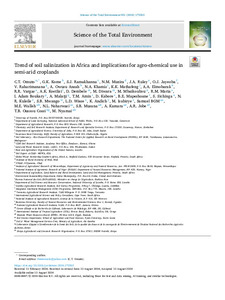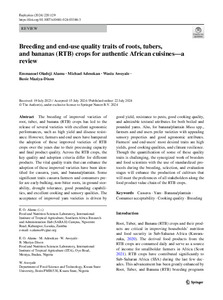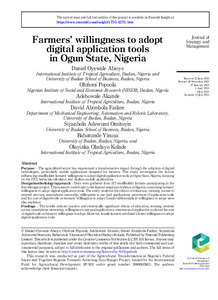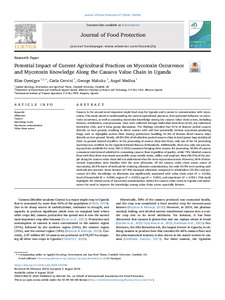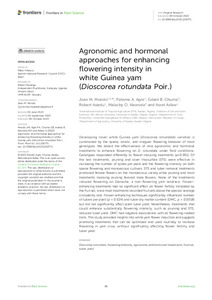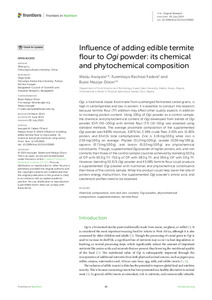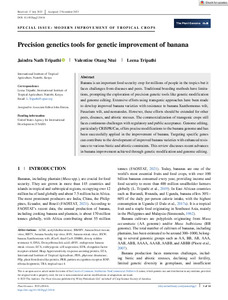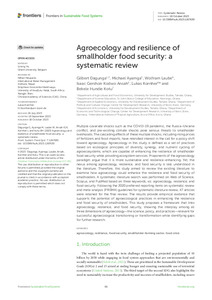Welcome to the International Institute of Tropical Agriculture Research Repository
Journal and Journal Articles: Recent submissions
Now showing items 81-100 of 5277
-
Too fast or too slow: the speed and persistence of adoption of conservation agriculture in southern Africa
(2024-11)Conservation agriculture (CA) represents a paradigm shift towards more sustainable and climate-smart intensification of smallholder farming systems in southern Africa. This can only be achieved with reasonably fast, widespread, and sustained adoption of CA. However, many farmers are slow to adopt CA and when they do, they often do not continue using it and eventually dis-adopt. We combine duration models and quantile regression models to study how long farmers take to adopt conservation agriculture ... -
Conservation agriculture practices: adaptation and yield
(2024)Conservation agriculture (CA) has been promoted in sub-Saharan Africa (SSA) to increase crop productivity and for climate change adaptation. CA is the simultaneous application of the three principles: no-till, mulch cover, and crop diversification. The potential benefits are largely linked to moisture conservation of crop residues, reduced run-off and erosion, increased infiltration, and reduced evaporative losses. This study uses a review of recent literature in SSA under rain-fed conditions to ... -
Trend of soil salinization in Africa and implications for agro-chemical use in semi-arid croplands
(2024-11-15)Soil salinization is a gradual degradation process that begins as a minor problem and grows to become a significant economic loss if no control action is taken. It progressively alters the soil environment which eventually negatively affects plants and organism that were not originally adapted for saline conditions. Soil salinization arises from diverse sources such as side-effects of long-term use of agro-chemicals, saline parent rocks, periodic inundation of soil with saline water, etc. In Africa, ... -
Breeding and end‑use quality traits of roots, tubers, and bananas (RTB) crops for authentic African cuisines—a review
(2024-07-22)The breeding of improved varieties of root, tuber, and banana (RTB) crops has led to the release of several varieties with excellent agronomic performances, such as high yield and disease resistance. However, farmers and end users have hampered the adoption of these improved varieties of RTB crops over the years due to their processing capacity and final product quality. Across the RTB crops, the key quality and adoption criteria differ for different products. The vital quality traits that can ... -
Unanswered questions and unquestioned answers: the challenges of crop residue retention and weed control in conservation agriculture systems of southern Africa
(2024-02-22)Production and utilization of crop residues as mulch and effective weed management are two central elements in the successful implementation of Conservation Agriculture (CA) systems in southern Africa. Yet, the challenges of crop residue availability for mulch or the difficulties in managing weed proliferation in CA systems are bigger than a micro-level focus on weeds and crop residues themselves. The bottlenecks are symptoms of broader systemic complications that cannot be resolved without ... -
Genome-wide association studies reveals new candidate genes associated with resistance to Striga gesneroides in Cowpea [Vigna unguiculata (L.) Walp.] accessions from sub-Saharan Africa
(2024-09)Parasitic plant Striga gesneroides reduces cowpea productivity in sub-Saharan Africa, leading to substantial yield losses. This weed is the major reason for land abandonment by many farmers. While various methods have been proposed for managing Striga invasion and parasitism, host-plant resistance remains the most effective and affordable option for small-scale farmers in the sub-region. This study aims to expedite the improvement of Striga resistance breeding through marker-assisted selection by ... -
Farmers’ willingness to adopt digital application tools in Ogun State, Nigeria
(2024-09-03)Purpose The agricultural sector has experienced a transformative impact through the adoption of digital technologies, particularly mobile applications designed for farmers. This study investigates the factors influencing smallholder farmers' willingness to adopt digital application tools in Ogun State, Nigeria, focusing on the IITA herbicide calculator and Akilimo mobile applications. Design/methodology/approach Data were gathered from 572 smallholder farmers participating in the Zero Hunger ... -
Potential impact of current agricultural practices on mycotoxin occurrence and mycotoxin knowledge along the cassava value chain in Uganda
(2024-08-06)Cassava is the second most important staple food crop for Uganda and is prone to contamination with mycotoxins. This study aimed at understanding the current agricultural practices, their potential influence on mycotoxin occurrence, as well as assessing mycotoxin knowledge among key cassava value chain actors, including farmers, wholesalers, and processors. Data were collected through individual interviews (210), key informant interviews (34), and 4 focus group discussions. The findings revealed ... -
Performances of plantlets from selected cassava (Manihot esculenta Crantz) genotypes under Semi-Autotrophic Hydroponics (SAH) using different substrates
(2023-01)The cassava seed system faces challenges due to limited seed stock caused by a slow propagation rate and a lengthy growth period. Conventional methods lacking phytosanitary guarantees further compound these issues. To address these limitations, the Semi-Autotrophic Hydroponics (SAH) technology was adopted for the rapid mass propagation of healthy, disease-free cassava plants. This research aimed to evaluate the performance of cassava planting materials using different substrates for stem-cutting ... -
Agronomic and hormonal approaches for enhancing flowering intensity in white Guinea yam (Dioscorea rotundata Poir.)
(2023-10-09)Developing novel white Guinea yam (Dioscorea rotundata) varieties is constrained by the sparse, erratic, and irregular flowering behavior of most genotypes. We tested the effectiveness of nine agronomic and hormonal treatments to enhance flowering on D. rotundata under field conditions. Genotypes responded differently to flower-inducing treatments (p<0.001). Of the test treatments, pruning and silver thiosulfate (STS) were effective in increasing the number of spikes per plant and the flowering ... -
Determination of abundance and symbiotic effectiveness of native rhizobia nodulating soybean and other legumes in Rwanda
(2024-04)Rhizobia diversity in the rhizosphere is one of the key promoters of biological nitrogen fixation between host legumes and microsymbionts, although related complex interaction may depend on various factors. This research was intended to assess the abundance of indigenous rhizobia isolates under various soil conditions, as well as their effectiveness to nodulate legumes such as soybeans. Factors such as soil properties and legume species influence the volume and symbiotic effectiveness of native ... -
Influence of adding edible termite flour to Ogi powder: its chemical and phytochemical composition
(2024-07-05)Ogi, a traditional staple food made from submerged fermented cereal grains, is high in carbohydrates and low in protein. It is essential to conduct this research because termite flour (TF) addition may affect other quality aspects in addition to increasing protein content. Using 100 g of Ogi powder as a control sample, the chemical and phytochemical content of Ogi developed from blends of Ogi powder (OP) (50–100 g) with termite flour (TF) (10–50 g) was assessed using standard methods. The average ... -
Effect of combined use of supplementary irrigation, manure and P fertilization on grain yield and profitability of soybean in northern Nigeria
(2024-04-14)Declining soil fertility particularly phosphorus deficiency, low organic carbon, moisture stress and high cost of input are factors limiting soybean yield in the Nigeria savanna. Supplementary irrigation, nutrient application and inoculation with Bradyrhizobium could increase the grain yield of soybean. We evaluated the effects of Rhizobia inoculant, phosphorus fertilization, manure, and supplementary irrigation on the nodulation and productivity of a tropical soybean variety in two locations in ... -
Genetic diversity of cassava landraces and documentation of farmer's knowledge in Lamu, Kenya
(2024)To develop a strategy for improvement of cassava (Manihot esculenta Crantz) productivity for climate change preparedness in Lamu County, Kenya, it was important to understand which cultivars farmers are growing. Landraces should be collected and conserved prior to replacement by improved cultivars to avoid erosion of genetic resources and associated farmer knowledge. In this study, 58 samples of landraces were collected from five administrative wards in Lamu County. These were SNP genotyped using ... -
Enhancing youth's retention in potato farming enterprise through consortium agribusiness models in Tanzania
(2024-05)The future of African youth probably lies in agriculture; however, this can be realized by making agriculture both profitable and attractive to young people. The importance of increasing youth involvement in agricultural value chains is primarily to sustain food production and secondly to reduce youth unemployment. Youth can be involved in various segments of agriculture and food value chains including production, post-harvest handling, distribution, value addition, and marketing. In Tanzania, ... -
Precision genetics tools for genetic improvement of banana
(2024-06)Banana is an important food security crop for millions of people in the tropics but it faces challenges from diseases and pests. Traditional breeding methods have limitations, prompting the exploration of precision genetic tools like genetic modification and genome editing. Extensive efforts using transgenic approaches have been made to develop improved banana varieties with resistance to banana Xanthomonas wilt, Fusarium wilt, and nematodes. However, these efforts should be extended for other ... -
Collection of cassava landraces and associated farmers' knowledge, genetic diversity and viral incidence assessment in western Kenya
(2024)Cassava is a crucial food crop in the western region of Kenya, producing 60% of the country’s production. It is mainly grown by small-scale farmers for subsistence use, with any surplus being sold. Many cassava landraces from the western region have been seriously affected by two viral diseases, cassava mosaic disease (CMD) and cassava brown streak disease (CBSD) but have not been conserved, together with associated farmer knowledge, in national or international germplasm repositories. This study ... -
Genomic prediction of the performance of tropical doubled haploid maize mines under artificial Striga hermonthica (Del.) Benth. infestation
(2024)Striga hermonthica (Del.) Benth., a parasitic weed, causes substantial yield losses in maize production in sub-Saharan Africa (SSA). Breeding for Striga resistance in maize is constrained by limited genetic diversity for Striga resistance within the elite germplasm and phenotyping capacity under artificial Striga infestation. Genomics-enabled approaches have the potential to accelerate identification of Striga resistant lines for hybrid development. The objectives of this study were to evaluate ... -
Effect of packaging and storage conditions on the pasting and functional properties of pretreated yellow-fleshed cassava flour
(2024-08-14)Cassava is highly susceptible to post harvest physiological deterioration which makes it necessary to initiate processing so as to extend the shelf life. In order to improve and enhance the nutritional characteristics of the processed cassava flour, this research was carried out so as to evaluate the adequate packaging materials and storage conditions necessary for safe storage and good flour quality. Pasting properties of food/flour is an indication of the different applicability of starch-based ... -
Agroecology and resilience of smallholder food security: a systematic review
(2023)Multiple covariate shocks such as the COVID-19 pandemic, the Russia–Ukraine conflict, and pre-existing climate shocks pose serious threats to smallholder livelihoods. The cascading effects of these multiple shocks, including rising prices of fertilizers and food imports, have rekindled interest in the call for a policy shift toward agroecology. Agroecology in this study is defined as a set of practices based on ecological principles of diversity, synergy, and nutrient cycling of agroecosystems, ...


